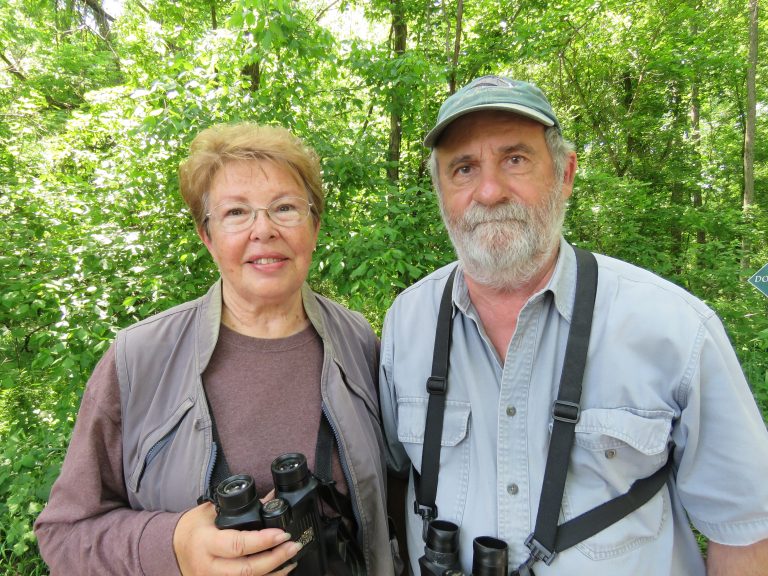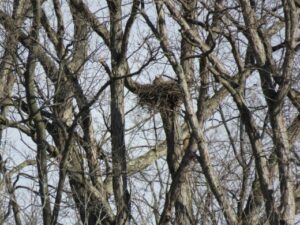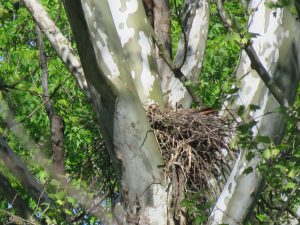By Ashley Peele

BJ and Jon Little
A refrain that many of you will hear from me is that people are the critical factor in wildlife conservation. People will determine the future of our natural resources and thus the future of birds. The VA Breeding Bird Atlas project seeks to give people an opportunity to embrace this idea and to do something about it. For this latest Atlas volunteer story, I want to write about Jon and BJ Little for two reasons. First, they bring their own unique experience and skillset to the VA Breeding Bird Atlas project and two, they have embraced the idea that it is up to us, people, to understand and conserve birds.

Bald Eagle Nest (Jon Little)
Jon and BJ live in Winchester, a city in the far northwest corner of the state that blends into the tangle of mountains and valleys in eastern West Virginia. Like many of us, both became aware of birds as children, but didn’t begin truly birding until their adult years. BJ is a Virginia native, while Jon grew up in Minnesota. He spent 25 years in South Dakota and, much to my delight, became a serious birder through his work on SD’s first breeding bird atlas. Back in MN, Jon and a friend conducted an extensive study of hawk nests, work that was published in The Loon (journal of the Minnesota Ornithologist’s Union). This sparked a continuing interest in mapping hawk nests, experience from which the VABBA2 project is benefitting!
Already both serious birders, Jon and BJ met while out with the genial Snickers Gap Hawkwatch group. They birded San Diego and the Salton Sea for their honeymoon trip and now in retirement, bird every day. Like many birding couples, they share the tasks of collecting field data. Jon drives and BJ records. Jon’s sharp eyes focus on photography and butterfly ID, while BJ handles the bird sounds and plant IDs.

Great Horned Owl Nest (Jon Little)
In the late winter and early Spring, when nests are so much easier to find, Jon and BJ spend many hours scouting for raptor nests. In 2017, they found and monitored 16 Bald Eagle, 2 Great-Horned Owl, 4 Red-shouldered Hawk, and 26 Red-tailed Hawk nests, a total of 48 nests! Jon also shared some great advice on finding raptors nests in a post to the Atlas community.
BJ shared some wonderful points on why she uses eBird and why she atlases… “I started eBirding soon after eBird started, because I live in an area with fewer birds and birders than some other parts of the state. I thought recording data from here was important in the overall picture. I felt I owed it to the birds to put them on the record.
Then I realized that there are more birds in my life because of eBird. Yes, I can search eBird to find tasty places to visit, like Green Cay in Palm Beach Co., Florida. But more importantly, eBird values every bird and makes me bird more carefully. Because I checked in the binoculars to be sure that the bird teed up on a stick in a pasture really was a Bluebird, I saw the five Horned Larks that settled in around him. Because I stood and waited (and waited) for the little brown job that dove into the fencerow briars to pop back up, or at least chip to me, I saw the Cooper’s Hawk I had not noticed, swoop down out of the back of the tree and zoom low across the pasture and away.
Now, I find atlasing to have the same enhancing effect. I have to go beyond just identifying the birds and pay attention to what they are actually doing, to watch Blue-gray Gnatcatchers gathering pieces of lichen for their gorgeous little nest, to puzzle through aging the Ruby-throated Hummingbirds in a zoom-fest between feeders in my son’s Nelson County backyard, and lately, to investigate singing female orioles. It’s making me a better birder.
On behalf of the birds, Atlasing also connects us with a web of information from the past and for the future. Not only is it interesting to compare and contrast data from the first and second atlases, with all their ramifications from land use to hard science, but we are also collecting data that will be useful to future scientists as the planet warms and habitats change. I feel fortunate to have the opportunity to participate in this endeavor.

Red-tailed Hawk nest (Jon Little)
The more we know, the better for the birds.”
The Atlas project feels fortunate to have incredible people like Jon and BJ, who donate so much of their time and energy to this effort. With a community of people like them, the future of Virginia’s birds is much brighter. Hopefully their story resonates with others who share their passion for conservation and provides a little more insight into why the Atlas community is a vital part of preserving VA’s birds for future generations.
~ Ashley Peele, PhD, State Coordinator, VA Breeding Bird Atlas

